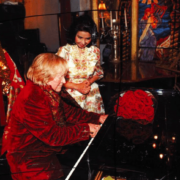Hollywood: His was an era of the musician pianists, faithful to the music in their fashion. Touched by God, he is no longer beholden to the pianistic musicality of fantasies, the improvisations, and acrobatic exhibition of the 1830s nostalgia of Parisian Salons.
Through the years, as several major schools began to appear, the severe German style, the warm Russian ones, the elegant French, and the eclectic English, that was the artist—now an interpreter—played the real music.
On a recent Sunday, the Maestro Dexter Grey, and his beloved wife, Dr. Linda Grey, who was celebrating her birthday, gathered a few close friends at their Hollymont castle, and enthralled each one to a magnificent concert. The Maestro bowed gently, his gestures grand, as he spread out his arms wide to subdue the rousing admiration from the audience.
That was even before Maestro Dexter Grey played a note.
His repertoire was like stepping into another time, another world, as the Maestro transported us into bygone eras. A time when love meant “to go out and love and suffer, yet still celebrate love’s strength and not complain of its difference. He brings to the audience an entire cauldron of feelings, tenderness, romance and nostalgia, a path of deep spirituality and incomparable poignancy. At 83 years old, the Maestro is always in search for new, richer and deeper views of views of musical interpretations.
One of these interpretations was a quest for freedom. A musical story of a people as they fall into mourning over the fate of their country. Regret, and resignation wept through his blessed fingers, then joy and redemption. His fingers flutter into the lyrical parts, like two butterflies. So light and delicate, you can not imagine they would be able to bring out the impossible fortissimo of an exultant victory at the end (the same performance created a splash at the Great Wall of China, many years ago).
Considered by world critics to be one of the greatest living interpreter of the music of Frederic Chopin, our conversation flourished over the Polish composer and virtuoso pianist.
MDL: Maestro, among the other pieces of Chopin—sherzos, rondos, variations, barcarolles and impromptus—which one would you single out?
Maestro Dexter Grey: It is the highly popular “Fantasy Impromptu” published posthoumously. It is not a first class Chopin, the composer himself thought so little of it that he never permitted its publication.
MDL: What about his Polanaises and Marzurkas?
MDG: Neither one of these two pieces have equaled the popularity of this waltzes, nocturnes or etude. But they were among Chopin’s most powerful and original works representing the more dynamic facets of his personality.
MDL: Maestro, how would you account for the amazingly high percentage of masterpieces of Chopin’s output?
MDG: His delicate embellishments, sometimes with powerful arpeggios, his slow movements that is poetic and sentimental as a romance (romanza).
MDL: Among the finest music produced by Chopin, if not by any romantic composer, is the “Sonata no. 4 in B minor”—not to be confused with the most famous Funeral March in all musical literature. Why so Maestro?
MDG: The “Sonata no. 3 in B minor,” is not a formal funeral march, but a poetic expression of restrained grief: music in the grand manner. It is dramatic, heroic and yet of quick silver motion.
MDL: The Chopin that most often comes to mind is the sensitive dreamer, the yearning romantic.
MDG: Of course, this is found in his many works notably the nocturnes… but in the waltzes, he is the sophisticated child of the Parisian salon, in the Mazurkas and Polanaises, he is the fiery, passionate, nationalist given often to tempestuous even savage declarations, he is a dramatist and poet in a grand scaled in the ballades but an exquisite miniaturist in the preludes and etudes.
MDL: I’ve read that the waltzes of Chopin were inspired by the Viennese pieces of the first Johannes Strauss, the father of Strauss who composed the “Blue Danube.” Is this true Maestro?
MDG: Strauss music was written primarily for dancing. The waltzes of Chopin is for listening; dances for the soul, not for the body and there is another important difference, the waltzes of the first Johann Strauss had an abandon betraying their peasant ancestry those of Chopin are the off spring of the Parisian saloon and are refined elegant and suave.
Through the years, the Maestro’s output was as exquisite as the Polanaise. He gave us two hours of poetry, passion and inspiration – graceful salon pieces, in a melancholic numbers of variation – rondos, marches, nocturnes, and sonatas. His performance rolled up the keys in arpeggios, bringing the audience to a frenzy, with boldness of attack or light handed playing with charm and rhythmic volatility. Described by critics as similar to a pleasurable electric shock passed through the audience, he put them under a spell bound with his powerful hand — yet possessed a certain gentleness.
At the end, one would realize that although there are a lot of good pianists in the world, he is the ONLY one that can give the audience a musical feeling that cannot be equaled.








Do you know the value of Maestro Grey’s autograph?